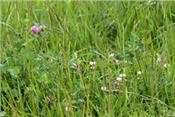|
Frost Seeding Improves Yield, Quality

Broadcast legumes when there is snow or frost on the ground to improve pasture quality and profits,
says Craig Roberts, University of Missouri Extension state forage specialist.
Photo by Linda Geist.
COLUMBIA, MO.
Forage yield Ond quality improve when legumes are frost-seeded at the right time, says University of Missouri Extension state forage specialist Craig Roberts.
Frost seeding, a method of broadcasting seeds over snow- or frost-covered pastures, improves poor pastures at a low cost. Seeds work their way into the soil and germinate as the ground freezes and thaws between winter and spring.
Frost seeding requires less fuel, labor and equipment than other methods, Roberts says. It works at a time when heavy equipment could rut and compact wet fields.
When to frost seed in Missouri
In most of Missouri, broadcast annual lespedeza, red clover or white clover in mid-February when there is snow or heavy frost. Frost seed in late January in southern regions or late February in northern counties of Missouri.
Seeds need to contact soil
Seeds need the freeze-and-thaw action for good seed-to-soil contact and to pull the seed to the soil’s top layer, Roberts says.
The best contact occurs on exposed soil. Plant residue prevents seeds from reaching soil. The hoofing action of cattle can work seeds into the soil.
Reduce competition from grasses
New plants need time to grow without competition from grass canopies for light and nutrients, so apply little or no nitrogen in spring. Graze or clip frost-seeded pastures in spring and summer to allow light to reach seedlings.
How much seed?
Roberts offers these pound-per-acre guidelines:
Red clover: 4-6.
White clover: 1/2 to 2.
Annual lespedeza: 6-8 if allowed to reseed the first year; 12-15 if reseed is unlikely.
See the MU Extension publication “Seeding Rates, Dates and Depths for Common Missouri Forages” at extension.missouri.edu/p/G4652.
Legumes cut fertilizer costs
Legume root nodules fix nitrogen from the air. In a typical year, fixed nitrogen replaces 25 pounds per acre of fertilizer.
“Legumes make free fertilizer and save money,” says Roberts. This free nitrogen boosts protein levels in the grass.
Because of this, hold off on spring nitrogen. “Go for zero nitrogen in the first spring,” he says.
Nitrogen causes established grasses to grow and smother legume seedlings. Wait until fall when root systems are strong, says Roberts.
For more information, see “Inter-Seeding Legumes in Pastures Can Offset High Nitrogen Prices(opens in new window)” in the MU Integrated Pest & Crop Management newsletter (ipm.missouri.edu/IPCM).
Legumes improve animal health, profits
Legumes extend the grazing season by producing better in late spring and summer, when fescue does not grow or grows slowly. Legumes nourish cattle during the “summer slump.”
Adding red clover to common tall fescue fields solves some animal health issues, Roberts says. More than 90% of Missouri fields contain toxic Kentucky 31 tall fescue. Adding legumes limits fescue toxicosis by diluting pastures.
Adding red clover also reduces vasoconstriction, the narrowing of blood vessels. In summer, vasoconstriction causes heat to build up in an animal’s core body. In winter, blood does not flow to extremities and hooves fall off. Compounds in red clover open blood flow to prevent this.
Roberts recommends pasture renovation workshops from The Alliance for Grassland Renewal. “They are the No. 1 workshops for Missouri forage-livestock producers,” he says.
Register at GrassLandRenewal.org/workshops. ∆
|
|